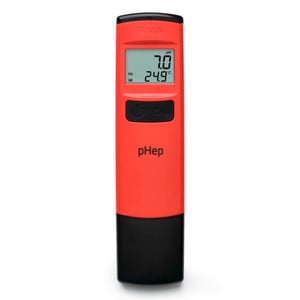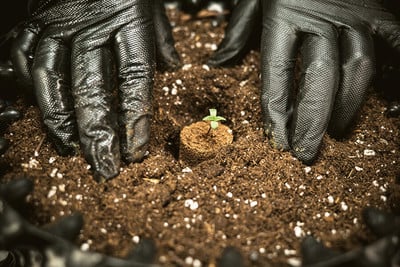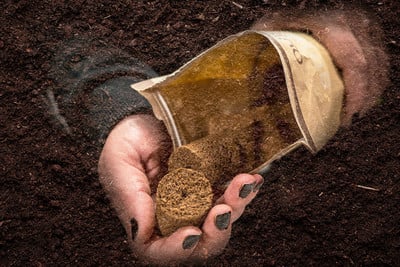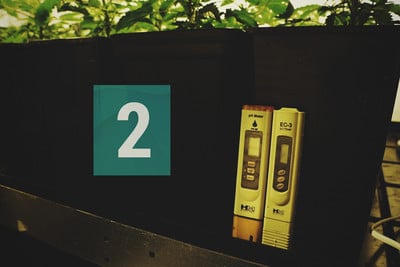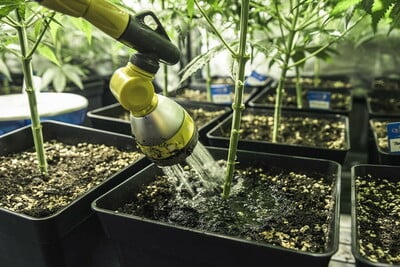 Weed Grow Guide by Royal Queen Seeds
Weed Grow Guide by Royal Queen Seeds
- Growing weed step by step
- Cannabis growing basics
- Choosing your seeds
- How to germinate seeds
- The cannabis vegetative stage
- The cannabis flowering stage
- Harvesting cannabis
- Trimming, drying, and curing
- Choosing pots and soil
-
Growing indoors
- A Complete Overview Of Growing Cannabis Indoors
- Cannabis Cultivation Tips: How To Set Up Indoor Grow Lights
- How Many Cannabis Plants Can You Grow Per Square Metre?
- Indoor Cannabis Growing: Relative Humidity and Temperatures
- Hydroponics Cannabis Growing Guide (with diagrams)
- Cannabis Micro Growing: Growing Great Weed in Tiny Spaces
- Growing outdoors
- How to grow autoflowering cannabis
- Cannabis nutrients and pH
- Cannabis troubleshooting: Nutrients
-
Cannabis troubleshooting: Growing
- Cannabis Seed Germination — Troubleshooting Guide
- How to Deal With Pythium (Root Rot) in Cannabis Plants
- Slow Cannabis Plant Growth And What You Can Do About It
- How to Prevent and Fix Stretching in Cannabis Seedlings
- Watering Your Cannabis: How to Fix Overwatering and Underwatering
- Understanding Male, Female, And Hermaphrodite Cannabis
- Identifying and Treating Common Cannabis Ailments
- How To Revive a Sick Cannabis Plant
- How to Avoid Mouldy Weed During Drying and Curing
- How to Prevent and Treat Dry and Crispy Cannabis Leaves
- What Cannabis Leaves Can Tell You
- Causes and Solutions for Yellow Cannabis Leaves
-
Cannabis Strains Grow Report
- HulkBerry Automatic Grow Report
- Blue Cheese Auto Grow Report
- Purple Punch Automatic Grow Report
- Triple G Automatic Grow Report
- Do-Si-Dos Automatic Grow Report
- Green Gelato Automatic Grow Report
- Haze Berry Automatic Grow Report
- Purple Queen Automatic Grow Report
- Cookies Gelato Automatic Grow Report
- Sherbet Queen Automatic Grow Report
- Sweet Skunk Automatic Grow Report
- Medusa F1 Grow Report
- Cannabis plant training
-
Weed growing tips
- The Cannabis Plant Anatomy
- How to preserve seeds
- How Much Sunlight Do Outdoor Cannabis Plants Need To Grow?
- How to Control and Prevent Stretching in Cannabis Plants
- My Cannabis Plants Are Growing Too Tall: What Should I Do?
- Should You Worry About Purple Or Red Cannabis Stems?
- What To Do When Your Indoor Cannabis Won’t Flower
- How To Protect Your Cannabis Plants From Heat Stress
- How To Tell If Your Female Cannabis Plant Has Been Pollinated
- Growing Medical Marijuana
- Bud Washing: How to Clean Your Weed
- Understanding Cannabis Yield per Plant

How To Water Cannabis Plants: A Comprehensive Guide
Watering cannabis plants seems like the easiest thing to do, yet many growers, especially those new to cannabis cultivation, make mistakes with watering. Overwatering is one of the most common reasons for all sorts of growing troubles such as nutrient deficiencies and cannabis diseases, although giving your plants too little water can also negatively affect their growth.
Contents:
How Much Water Does a Weed Plant Need?
Without consistent watering, weed plants quickly wilt and die. It might not seem like it to the naked eye, but cannabis plants are primarily composed of water; they’re 80–95% H₂O. They need the substance to fulfil several critical functions, including photosynthesis. Water also gives plants their turgidity by filling vacuoles—specialised organelles within plant cells. But how much water does a weed plant need to grow optimally? Because there are so many variables involved in growing cannabis, there’s no fixed recommendation when it comes to watering.
Despite the variables of climate and cultivar selection, the Emerald Growers Association and the Mendocino Cannabis Policy Council conducted a poll[1] on water use among cannabis farmers. These professionals apply an average of 4.5l per day for each 500g of processed flower expected following harvesting. Based on this, growers can obtain average yield data from their seed bank of choice and develop an approximated watering schedule.
Other cultivators prefer to do away with maths and simply feel things out. These growers look for signs of dehydration—light wilting, weak branches, pale leaves—and water accordingly.
Over time, you’ll develop a refined sense of when your plants require water based on the variables of climate, cultivar, and acute weather events.
How Much Should You Water Cannabis?
One issue with watering plants is that it isn’t really an exact science, and many different factors contribute to how much you should administer. As an obvious example, as your plants get bigger, their watering needs will change. But there are other, more complex variables that also determine how much or little you should drench your plants. Let’s discuss some of the most vital:
1. Stage Of Growth
Cannabis plants have different watering demands depending on their stage of maturity. The specific guidelines we share below apply to mature vegetating and flowering plants. Seedlings and clones require much less water.
In the early stages, avoid watering your plants with a powerful stream that might knock them over and disturb developing roots. Instead, use a light mister to gently moisten the substrate.
Wait for the soil to dry out completely before repeating the procedure. How quickly the soil will dry will depend on your environmental conditions, but this roughly translates to misting once every 2–3 days.
2. Growing Medium
The type of growing medium you use largely determines how much water the soil can hold, and drainage plays a huge role in how often/how much you water your plants. Cannabis likes rich yet airy and “fluffy” types of soils that are well-draining. As another consideration, the growing containers themselves must have holes punctured in the bottom to allow the water to escape. More compact soil mixes will hold moisture much longer, so they require less frequent watering as a result. Otherwise, moisture can linger in the soil for some time, which can lead to nutrient deficiencies, root rot and fungus, pests, and a whole lot of other problems.
Here is a quick way to check if your water is draining properly: If it takes several minutes for water to drain after drenching the soil, and/or if it takes longer than 3–4 days for your soil to dry out, it’s likely that you have a drainage issue. Even if you don’t see adverse symptoms now, it could definitely lead to more problems down the line. In this case, you can add perlite or something similar to your soil to aerate the mix and improve its drainage ability. Perlite ensures that water doesn’t stay too long in your pot. The key to good soil for cannabis plants, whether shop-bought or homemade, is to balance moisture retention with water drainage. This usually means soil that is dark and rich, but amended with perlite and/or other substances to promote a healthy and efficient medium for plants to grow.


3. Size Of Container
Then of course, the dimensions of your container will also affect the overall balance between moisture retention and drainage. If you have a tiny plant in a huge pot, drenching the whole substrate is going to drown the poor thing before it gets a chance to flourish. Similarly, you might experience the opposite issue with huge root-bound plants stuck in minuscule pots. This is also the reason that growers normally start seedlings in smaller pots, then up-pot them later as the plant grows. A small seedling pot makes it much easier not to overwater the sensitive seedling.
4. Outside Temps And Light Intensity
Cannabis plants don’t always grow at the same pace. A plant in a cooler environment, for example, will grow much slower than one under balmier conditions. Light intensity plays another big role here. Plants that receive more heat and light are bound to have higher water and nutrient requirements than those with meagre light and chilly temps.
5. Health Of Cannabis Plants
The general health and vitality of your plants will also determine how much water they require. If growth is slow or stunted, or if a plant is afflicted with diseases or pests, it will likely not need as much water as one that is thriving.
How Often to Water Weed
After inquiring about how much water weed plants need, growers drift to the next question in the natural order: How often should I water my plants? Again, it all depends on the variables at play—e.g. soil composition, average daytime temperature, climate, and growing style (in containers vs directly in the ground).
As a general rule, many growers find success through the simple method of monitoring soil dryness. Once the top 5cm of soil becomes completely dry, your plant could do with another drink. Depending on your soil type and climate, you might find that this means watering your plants once per day, or once every few days.
Drip irrigation systems remove the need to manually water plants. However, you’ll need to adjust the flow rate during extremely wet weather (if you’re not growing under cover) or dry spells to avoid overwatering and underwatering.
? Best Time to Water Weed Plants
Early in the morning before sunrise or later in the evening after sunset are the best times to water weed plants. During the peak of the season, things heat up quickly during the day and the evaporation rate increases. Water droplets on leaves can also magnify sunlight and cause tissue damage.
How To Tell If Your Plants Are Thirsty
You now know about the factors that determine how much and how often cannabis plants need water, and how these factors can be different for everyone. So now, how can you tell exactly when you should water?
Here are some signs that your cannabis plants are thirsty:
-
Drooping, Weak Plants
If your cannabis plants are very thirsty, they will droop. The whole plant will appear rather sickly and lifeless, so it’s difficult to overlook this sign. One catch here though is that thirsty plants can look very similar to those that are drooping because of overwatering. The difference here is that the leaves of overwatered plants are usually dark green and form a “claw” where they curl and bend downwards, so the whole plant takes on a heavy and waterlogged appearance.
If you’re somewhat experienced, you should be able to tell these conditions apart. Most of the time, it should be obvious if the drooping is from over or under-watering: If the soil is bone-dry and you know you haven’t watered in quite some time, the sickly appearance of your plants is less likely from overwatering.
Tip: Know that slightly underwatering your plants is always better than overwatering. If you water thirsty, otherwise healthy plants, they should normally recover their appearance in a couple of hours. Occasional underwatering doesn’t usually have harmful consequences. Overwatering, on the other hand, is a silent killer.

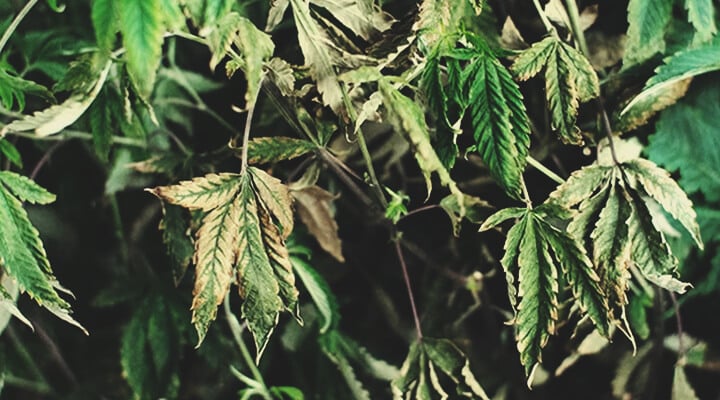
-
Yellow Or Brown Leaves
Along with your thirsty plant wilting and drooping due to a lack of water, it may also display discoloured leaves in shades of yellow and brown. While it is perfectly normal for plants to develop yellow leaves during the final weeks of bloom, a healthy vegetating plant shouldn’t have any/many dry, yellow, or brown foliage.
-
Just Check The Soil!
Take the guesswork out of your watering routine with a simple method. Placing the tip of your finger into the top 5cm of soil provides a good indicator of how dry the upper soil has become. However, it won’t allow you to detect the water content of the middle and bottom of the growing medium.
Weighing your pots instead will give you a clear picture of how much water remains. You can operate based on a general feeling of how your containers feel in your hands when they are dry compared to when they are saturated. Even better, weigh them to know exactly when they’re ready for some more H₂O.


How To Water Your Cannabis Plants
Here is a simple rule: Water less, but water well! Rather than giving your plants a little bit of water often, treat them to a healthy, less frequent soak. But how much water is sufficient?
A good soak means watering the medium to 25–33% of the pot capacity. This amount of water will provide the root system with all it needs, without causing pooling and potential fungal issues.
When watering, aim for the middle of the substrate first. After letting the roots breathe, water the edges of the container too. This approach will encourage the root ball to reach to the edges of the pot, and also shuttle nutrients sitting in the top of the medium down to the root system below.
This method will deliver the correct amount of water, without creating pools in the substrate. Excess water creates a humid environment—a perfect breeding ground for fungal pathogens that lead to root rot.
-
Don’t Leave Your Plants Sitting In Runoff
Along with your containers featuring holes at the bottom for water to escape from, the containers themselves should be lifted slightly off the ground so that all the water can drain and plants aren’t sitting in stale liquid. Drainage trays can catch this runoff, but should immediately be dumped after collection to avoid creating a breeding ground for bacteria, pests, and mould.
-
The Importance Of pH When Watering Plants
If you are growing cannabis organically in soil, you shouldn’t need to worry much about the pH level of your water/nutrient solution. But for the majority of cannabis growers who are using common mineral nutrients and grow weed in soil, coco, or hydroponically, the correct pH level of the water is very important.
The reason for this is that cannabis plants have a limited pH window where they are able to take in nutrients. If the pH level of the water is either too high or too low, the plants are unable to take in nutrients even if they are present, a phenomenon known as nutrient lockout.
When you grow in soil, the pH range of your water should be 6.3–6.8. If you grow soilless (e.g. coco) or hydroponically, the pH level needs to be even lower, 5.5–6.1. To test your water pH, use a pH measuring stick or pH measuring drops. If the pH is too high or too low, use some drops of “pH down” or “pH up” to adjust your water to the right level. Most of the time, if you’re using tap water, your pH will likely be too high.
Also, if you’re adding cannabis nutrients to your water, measure the pH after each feed. This will give you accurate data of how you have influenced the soil. It will also let you know if you need to add more nutes, or modify the dose during next feed.
How To Collect Water Runoff
Collecting water runoff serves as an effective and simple way to minimise overwatering. When you administer too much, plant pots can end up sitting in a pool of excess water that reduces aeration and gives pathogens favourable conditions to strike. Use the handy tips below to prevent this situation from arising.
-
Use Inclined Trays
The easiest solution? Gravity. By setting your trays at an incline, excess water will drain away from the containers and pool at the end of the tray. No, you don’t need any fancy gear. Place any spare waterproof item under the back end on the tray. You can use anything from water bottle caps to plastic lids. This gradual slope will allow water to run toward the front of the tray for easy removal.
-
How To Remove Water Runoff
What to do with all of that water pooling in your trays? Well, there are plenty of different ways to remove it. Check out a few below:
| Paper Towels | Cheap. Easy. Simple. If you’re only growing a few plants in a small space, just reach for some paper towels! Place them in the pool and let them draw up all of the water. When you’re done, throw them onto your compost pile. |
| Giant Syringes | Giant syringes are a handy and controlled way of removing water runoff. They reduce paper towel waste and allow you to squirt the excess water directly down the drain. A capacity of 100ml will suffice for a small growing operation, but you can purchase larger 500ml models if you have a lot of water to move. |
| Wet Vacuum | Wet vacuums are great for much larger growing operations: they take up a lot of water in a small amount of time. Realistically, you’ll only need one if you’re dealing with a lot of inclined trays. You should also consider that these devices are quite loud. If you’re looking to keep things low-key, choose a different option. |
| Paper Towels |
Cheap. Easy. Simple. If you’re only growing a few plants in a small space, just reach for some paper towels! Place them in the pool and let them draw up all of the water. When you’re done, throw them onto your compost pile. |
| Giant Syringes | Giant syringes are a handy and controlled way of removing water runoff. They reduce paper towel waste and allow you to squirt the excess water directly down the drain. A capacity of 100ml will suffice for a small growing operation, but you can purchase larger 500ml models if you have a lot of water to move. |
| Wet Vacuum |
Wet vacuums are great for much larger growing operations: they take up a lot of water in a small amount of time. Realistically, you’ll only need one if you’re dealing with a lot of inclined trays. You should also consider that these devices are quite loud. If you’re looking to keep things low-key, choose a different option. |
How To Water Cannabis Plants When You’re Away
There may come a time where you have to depart from your plants during the growing cycle. Sometimes holidays, commitments, and major events can force you to leave your plants for a period of time. While you can always leave the lights on and feed them before you leave, cannabis plants require water every few days.
If you’re away from the weekend, they’ll do just fine. But if you need to leave for longer, you’ll need to come up with a way to make sure their water demands are met. Check out some of the simple and creative ways below to keep your plants alive and thriving in your absence.
? Budget Options
You don’t need to invest significant time and money into finding a way to sustain your plants. Cheap and simple options work just as well. Check out the three most effective ways to keep your plants watered while on a budget below.
-
Ask A Friend
Ask a trusted friend! Of course, you’ll need to ask somebody that you trust completely. You don’t want word spreading about your botanical hobby, and you definitely don’t want flowers going missing.
If possible, recruit a friend who has some growing experience. This way, they’ll know how much water to administer and when. If you’re asking a friend new to the growing world, be sure to educate them about under watering and over watering to avoid root rot and nutrient lockout.
When you’re back, thank your friend with a smoking session and be sure to share some of your harvests as a thank you for their hard work.
-
DIY Drip System
Drip systems are an excellent way to provide a slow and steady supply of water to your plants. Instead of gushing water into your soil every now and then, drips systems supply a constant yet tiny quantity of water that adds up and drains evenly over time.
Grab a used water bottle and make a couple of holes in the cap using a hammer and nail. Fill the bottle with water and replace the cap. Dig a hole in your container or garden bed and place the bottle in cap side first. This method will keep your plants hydrated for about five days.


-
Makeshift Greenhouse
Using a simple plastic bag, growers can create a temporary makeshift greenhouse that recycles the water that plants release through their leaves. Place four wooden stakes evenly spaced in each corner of your container to form a support structure. Next, water your plant well and place it somewhere out of direct sunlight.
Grab a large clear plastic bag and cover your plant, resting the top over the four stakes. Use a piece of string to loosely bind the opening of the bag to the rim of the container, still allowing air to pass through. The bag works to form condensation and rain the water back down into the soil, creating a continuous cycle.

-
Automatic Watering Stakes
If you prefer to keep things low-tech, you should consider watering stakes. These cool little devices feature a small stake and a tube that connects the stake to a small water reservoir. You can use any small container as a reservoir, from a glass jar to a Tupperware container. Unscrew the cap on the stake and fill it with water. Then, insert the cap into the soil and place the end of the tube into the reservoir.
The water will wick through the tube, into the stake, and throughout the growing medium to keep your plants hydrated while you’re away. Although simple, water stakes do a great job at striking a balance. They release moisture at roughly the same rate that plants draw it up, minimising the risk of overwatering.


? High-Tech Options
If you have the money, why not splash out to keep your plants watered and your harvest safe? Some growers are willing to invest whatever it takes, and others simply enjoy geeking out on high-end growing products. Discover the two best high-tech option for keeping your plants hydrated while you’re away.
-
Irrigation System
Modern growers have the luxury of choosing from a wide range of irrigation products on the market. These devices use timers and controllers to water cannabis on demand. Tubing systems connected to a reservoir shuttle water to individual containers when and where a grower chooses. Some models are even wi-fi enabled and allow growers to change parameters via their smartphone.


-
Slow Drip System With Smart Timer
Slow drip systems with smart times are the high-tech version on the bottle trick explained above. These systems are super easy to put together at home and provide a constant trickle of water that keeps cannabis plants happy and hydrated.
Slow drip systems come with a hose, drip couplers, staples to keep the hose secured, and a hose timer. Growers can place the drip couples anywhere along the tube, enabling them to water individual plants spaced along garden beds and grow rooms. Simply set the start and endpoint on the timer to your preferred settings and you’re good to go.

Bottom Line — Water Well, But Not Too Often!
If you know how and when to water your plants, and are aware of any associated issues along the way, you can prevent most common cannabis growing problems. You will raise happy, healthy plants, and can look forward to fantastic yields!
Happy growing!
- How Much Water Does It Take to Grow Cannabis? - SoHum Living Soils https://sohumsoils.com
 Grow Guide Topic Finder
Grow Guide Topic Finder
- Growing weed step by step
- Cannabis growing basics
- Choosing your seeds
- How to germinate seeds
- The cannabis vegetative stage
- The cannabis flowering stage
- Harvesting cannabis
- Trimming, drying, and curing
- Choosing pots and soil
-
Growing indoors
- A Complete Overview Of Growing Cannabis Indoors
- Cannabis Cultivation Tips: How To Set Up Indoor Grow Lights
- How Many Cannabis Plants Can You Grow Per Square Metre?
- Indoor Cannabis Growing: Relative Humidity and Temperatures
- Hydroponics Cannabis Growing Guide (with diagrams)
- Cannabis Micro Growing: Growing Great Weed in Tiny Spaces
- Growing outdoors
- How to grow autoflowering cannabis
- Cannabis nutrients and pH
- Cannabis troubleshooting: Nutrients
-
Cannabis troubleshooting: Growing
- Cannabis Seed Germination — Troubleshooting Guide
- How to Deal With Pythium (Root Rot) in Cannabis Plants
- Slow Cannabis Plant Growth And What You Can Do About It
- How to Prevent and Fix Stretching in Cannabis Seedlings
- Watering Your Cannabis: How to Fix Overwatering and Underwatering
- Understanding Male, Female, And Hermaphrodite Cannabis
- Identifying and Treating Common Cannabis Ailments
- How To Revive a Sick Cannabis Plant
- How to Avoid Mouldy Weed During Drying and Curing
- How to Prevent and Treat Dry and Crispy Cannabis Leaves
- What Cannabis Leaves Can Tell You
- Causes and Solutions for Yellow Cannabis Leaves
-
Cannabis Strains Grow Report
- HulkBerry Automatic Grow Report
- Blue Cheese Auto Grow Report
- Purple Punch Automatic Grow Report
- Triple G Automatic Grow Report
- Do-Si-Dos Automatic Grow Report
- Green Gelato Automatic Grow Report
- Haze Berry Automatic Grow Report
- Purple Queen Automatic Grow Report
- Cookies Gelato Automatic Grow Report
- Sherbet Queen Automatic Grow Report
- Sweet Skunk Automatic Grow Report
- Medusa F1 Grow Report
- Cannabis plant training
-
Weed growing tips
- The Cannabis Plant Anatomy
- How to preserve seeds
- How Much Sunlight Do Outdoor Cannabis Plants Need To Grow?
- How to Control and Prevent Stretching in Cannabis Plants
- My Cannabis Plants Are Growing Too Tall: What Should I Do?
- Should You Worry About Purple Or Red Cannabis Stems?
- What To Do When Your Indoor Cannabis Won’t Flower
- How To Protect Your Cannabis Plants From Heat Stress
- How To Tell If Your Female Cannabis Plant Has Been Pollinated
- Growing Medical Marijuana
- Bud Washing: How to Clean Your Weed
- Understanding Cannabis Yield per Plant


























